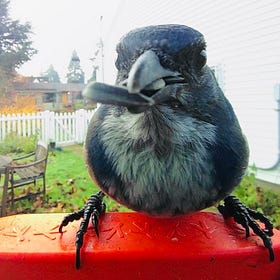
It’s happening! The small shrubs I planted in the fall—mock orange, salmonberry, red flowering currant, and snowberry—are nicely leafed out and appear happy in their new home. The mock oranges are already about a foot taller than when I bought them. They’re the biggest additions to this hedgerow we’re creating along the south and west borders of our yard.
My autumn sheet-mulching (cardboard directly over the grass, then compost or leaf mulch atop the cardboard) worked really well, with one hiccup: I didn’t reckon on the crows. In late winter they began pulling up the soggy cardboard to expose a buffet of worms. This feasting behavior resulted in messy scraps of half-decomposed cardboard all over the yard: not exactly the visual you want to present to your new neighbors.
But I’ve gotten that all cleaned up (it’s a fabulous addition to the backyard compost pile), and the good news is that the crows left it alone long enough for it to do about 80% of its job. The grass is mostly gone. I’ve spent the past two weeks digging out the last of it from this long, curving hedgerow that runs along the two street-sides of our corner lot. The soil underneath the leaf mulch is gorgeously rich.
I’ll still be doing battle with grass roots for a while to come, but I had great success with a quick-fix strategy in the side yard last summer and I’m excited to see how it works out in the hedgerow: I planted a few small native groundcover plants (mountain monardella was most successful) and filled in the areas between them with a lot of nasturtium and borage seeds. Nasturtiums are quick growers and by midsummer they were huge bushy mounds of flowers. The grass in that bed is now almost entirely gone.
If you don’t have crows ripping up your cardboard, you can do this trick directly on top of your sheet-mulch layer. That’s what I did last summer in this side-yard bed I’m talking about. Cardboard over the grass, a compost mix on top of that, and seeds directly in the compost. It’s the easiest flowerbed I’ve ever planted.
In the hedgerow, I’ve added a few more native shrubs (elderberry, huckleberry, another currant) and a few groundcover varieties (bearberry, native wild strawberry). Also lupines (already about to bloom, hooray), echinacea, catmint, milkweed, and a few other native goodies. That’s the end of the garden budget for this year, so anything else will have to be grown from seed. I’ve sown more borage and nasturtium, plus a lot of poppy seeds my friend Jenn sent me. Oh, and some pumpkins.
Meanwhile, in the side yard: excitement! The ailing bleeding heart I moved over from the old house is happier than it has ever been. I planted it in the overhanging shade of my neighbor’s maple, tucked between the columbines (native and not) sown by the former owner of our house. The bleeding heart is not a native variety, but a native volunteer has sprung up nearby. It was just a few tiny leaves last summer, and I was amused to find that was enough to “count” in the Backyard Habitat Certification site visit last fall.
Backyard habitat project update
Friday is are allergy-shot day, and whew, allergy shots wipe me out. I’m several months into a year-long series of weekly appointments, and then I’ll shift to self-administered shots for I’m not sure how long. When I say self-administered, I mean S…
This time last year, we had only just closed on the house. We didn’t move in until late May, so these April morning garden rambles are still full of surprises. I left the already existing borders alone to see what is already there before making any changes (the former owner was a fantastic gardener). All the plantings I’ve described above are only replacing grass, except for the bleeding heart.
Oh, and I’ve dug an asparagus bed! Only three summers to go before we can harvest!
I’m in no rush. Garden time is deliciously slow. Unless you’re a nasturtium.






